More Views Along The Decks Of The Queen Mary
Being able to walk the decks of a massive 1930s liner such as the
Queen Mary today is to me a wonderous thing. While most historic
non-war ships have met the breakers years ago, this one survives all
alone. The efforts made by the City of Long Beach way back in 1967
to acquire the ship must be recognized, despite the consistent errors
in decision making during her conversion. That she still survives in
a mostly intact form is pure miracle. And for now, we can visit her
any day of the year, and even stay aboard her in one of her many
hotel rooms, many of which reflect their original decor.

Bungee Tower next to Queen Mary in
1996
Here is a wide angle photograph of the ship from the edge of the rock wall
surrounding the ship. We see a massive bungee-jumping tower next to the
ship. While certainly an ugly addition to the profile of the ship from any angle,
it certainly did allow for some ambitious photographers to get a high angle
view of the ship. I would have done the same had it not been closed the day
I was at the ship.
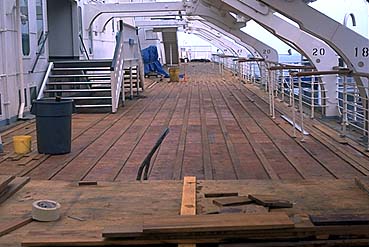
Sun Deck Port Side
Here is a view of the port side of Sun Deck in June, 1996. Currently this
area should be completed and open to visitors. Marine plywood is being
laid as a foundation over the steel deck and below the teak decking. The
scraps of teak decking seen in the foreground on the workbench are said
to be now given away as souveniers to current Captains Club Members.
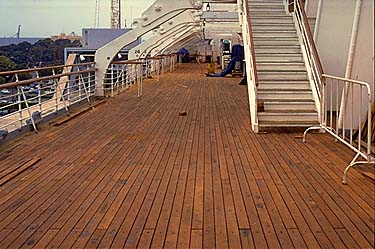
Sun Deck Teak Restoration
Here is the same area seen from the opposite angle. It is encouraging
to see the teak looking so new and clean. The main purpose of this work
is to prevent the decking below from rusting and leaking on to the
Promenade Deck.
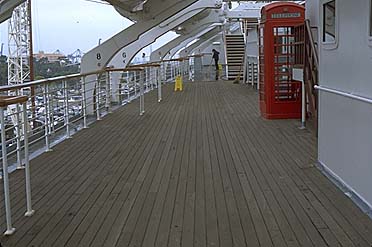
Port Side Sun Deck Awaiting
Restoration
Here is the area just forward of the last picture on the port side of Sun Deck.
The teak is being pressure washed in preparation for the resotration.
The grey color here is a result of not applying oil to the
decking on a regular basis, which allows the teak to dry out and weather much
more quickly. The cost of maintaing the teak decking is absurdly high.
An observer aboard QE2 would notice the teak on that ship,
30 years old now, is still warm in color due to proper maintenance.
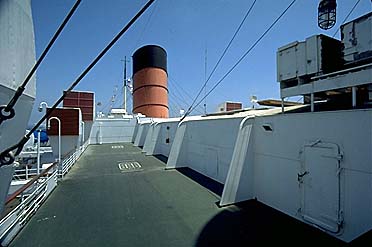
High Up on Sports Deck, Starboard Side
Here we are high up on Sports Deck on the starboard side of the ship. The
structure you see to the right is the dome over the First Class Lounge located
on Promenade Deck. The air conditioning units were added during the Long
Beach conversion days between 1968-71.
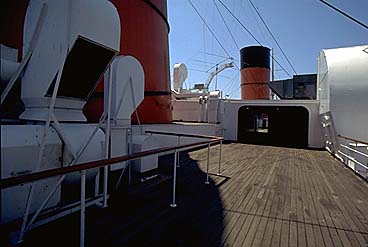
Sports Deck, Starboard
Side
Here is another view up on Sports Deck on the Starboard side. We
are standing in the same position as the last photograph, now looking towards the bow.
Up ahead of us on the left was the indoor squash/raquet court. All the
air conditioning equipment you see was added during the Long Beach conversion.
The Queen Mary had airconditioning only in the First Class Lounge and Dining Rooms during her service career,
unlike the Queen Elizabeth which was retrofitted with it throughout the entire ship in the early
1960s, as Cunard planned for the QE to sail in to the mid 1970s while
retiring the Queen Mary in the mid 1960s. Soaring oil prices combined with fewer and fewer passengers sailing aboard the Queens spelled their demise (It is said that one November crossing in the mid-1960s, the Queen Elizabeth carried only 145 passengers!!!).
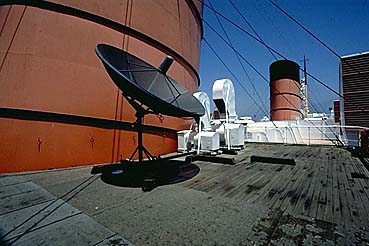
Queen Mary's Highest Deck
Here we are standing atop what was the gymnasium. While this was not
formerly a deck of the ship, it was teak decking therefore served some
purpose. The strange discoloring of the second funnel seen here is an
anomoly of electronic conversion of this image, and is not reflected in
the original slide. It is a shame the original funnels were in such a state of
disrepair when they were removed in 1968. It is said they were held together
by paint! When releaved of the guide wires that held them up as they were placed
on the dockside, it is said they literally crumbled.
These new ones are smooth, unlike the rivited funnels the Queen Mary was
originally equipped with until their demolition in 1968.









